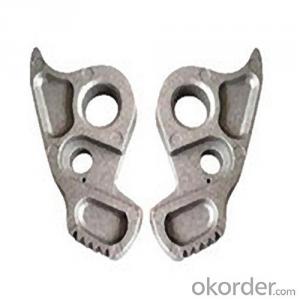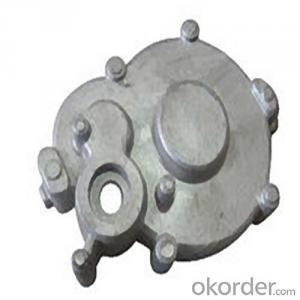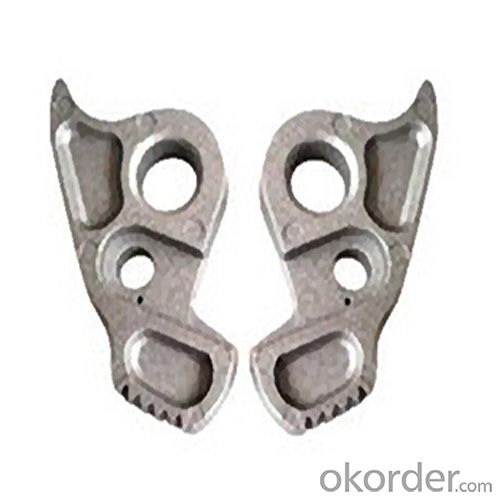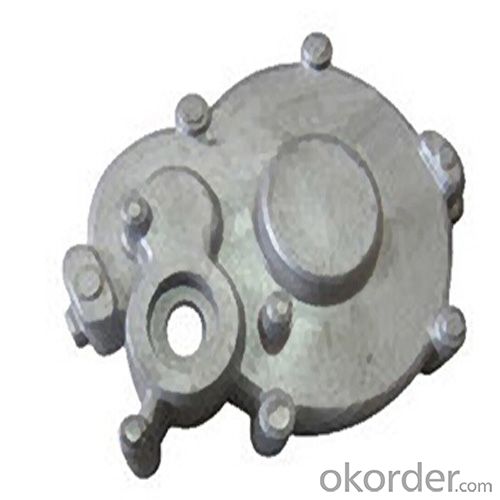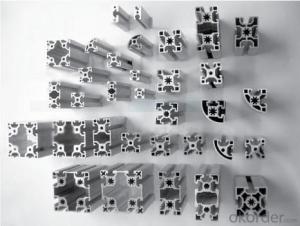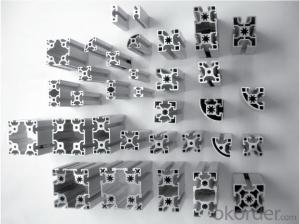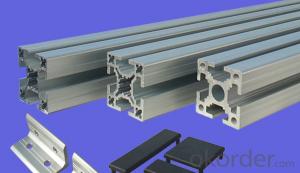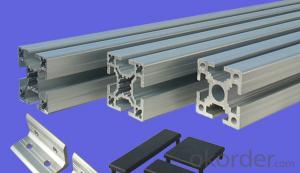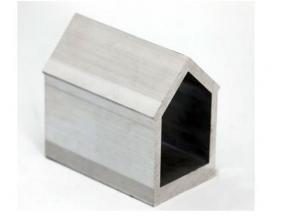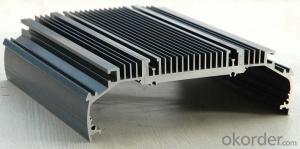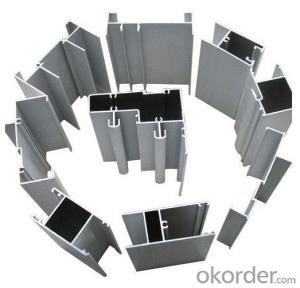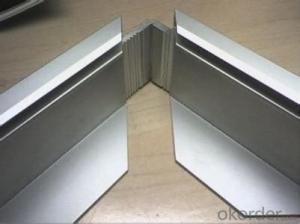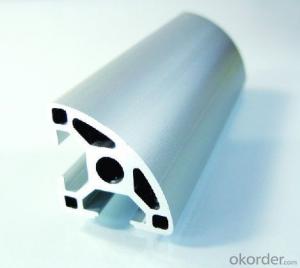Aluminum Extrusion Profiles Malaysia - Mold Metal Casting with High Quality and Best Price
- Loading Port:
- Guangzhou
- Payment Terms:
- TT OR LC
- Min Order Qty:
- 1000 pc
- Supply Capability:
- 100000 pc/month
OKorder Service Pledge
OKorder Financial Service
You Might Also Like
1. Structure of Mold Metal Casting Description:
The casting equipment and the metal dies represent large capital costs and this tends to limit the process to high volume production. Manufacture of parts using die casting is relatively simple, involving only four main steps, which keeps the incremental cost per item low. It is especially suited for a large quantity of small to medium-sized castings, which is why die casting produces more castings than any other casting process.[1] Die castings are characterized by a very good surface finish (by casting standards) and dimensional consistency.Two variants are pore-free die casting, which is used to eliminate gas porosity defects; and direct injection die casting, which is used with zinc castings to reduce scrap and increase yield.
2.Main Features of the Mold Metal Casting:
Die Casting
High Precison&Tolerance
Motor vehicle
External processing
3. Mold Metal Casting Images
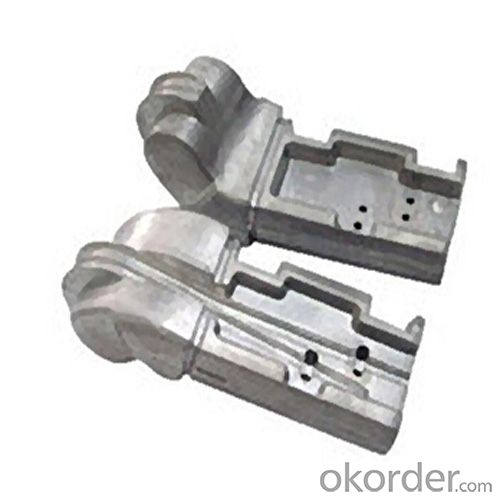

4. Mold Metal Casting Specification
| Material | aluminum alloy A380,A360.ADC12,Zinc alloy 3#zinc,5#zinc and 7#zinc,etc |
| Designs | 1.As per the customer’s drawings 2.As per the customer’s samples |
| Surface treatment | 1.sand blasting, 2.power coating 3.painting 4.anodization 5.electrophoresis 6.zinc plating 7.black oxidation. |
| Software | Pro/E, Auto CAD, CAXA UG, CAD/CAM/CAE |
| Certificate | ISO9001:2008, ROHS,SGS |
| Service | OEM service available |
| Products | All kinds of aluminum &zinc alloy casting: include automotive parts, railroad parts, medical parts, marine parts, lighting parts, pump body, valve parts, architectural parts and furniture parts so on |
| Advantage | 1.With 8 years in Aluminum & zinc alloy casting; 2.Near shanghai Port and Air Port; 4.Passed ISO9001:2008/Rosh/SGS 5.From Casting to Finished surface, Owned casting, polishing and plating workshops, We can offer Good quality and strict delivery time. 6.With samples and order: We can offer dimension report,Chemical composition and Mechanical properties |
5.FAQ
Q. What is Die Casting? How is it different from other "casting" process?
"Die casting is the process of forcing molten metal under high pressure into mold cavities (which are machined into dies). Most die castings are made from non-ferrous metals." It's known as "pressure die casting" in Europe. "Gravity casting" (a.k.a. "permanent mold casting" in USA and Canada) uses gravity to fill the mold.
Q. I don't have experience designing parts for make mold metal casting , and want to bring existing machined parts to die casting. What should I know?
We have a professional person to help you.
- Q: What are the necessary upkeep and care procedures for aluminum profiles post-installation?
- <p>After installation, aluminum profiles generally require minimal maintenance due to their corrosion resistance and durability. However, regular cleaning to remove dust and dirt is recommended to maintain their aesthetic appeal and performance. This can be done using mild detergents and water. Periodic inspection for any signs of damage or wear is also important to ensure the structural integrity of the profiles. In case of any damage, it should be promptly attended to to prevent further deterioration. Despite their low maintenance nature, it's crucial to follow the manufacturer's guidelines for care and upkeep to prolong the life of the aluminum profiles.</p>
- Q: How do I choose the right aluminum profile for my project?
- When choosing the right aluminum profile for your project, there are several factors you should consider. Firstly, you need to determine the specific requirements of your project. Consider the purpose and function of the aluminum profile, as well as any specific dimensions or specifications it needs to meet. This will help you narrow down your options and ensure you choose a profile that is suitable for your project. Next, think about the type of aluminum profile that would be most appropriate for your project. There are various types available, such as T-slotted profiles, angle profiles, or channel profiles. Each type has its own advantages and applications, so it's important to understand the differences and select the one that best fits your needs. Consider the strength and durability of the aluminum profile. Evaluate the load-bearing capacity and resistance to corrosion or other environmental factors. Depending on the nature of your project, you may need a profile that can withstand heavy loads or harsh conditions. Another important factor to consider is the compatibility of the aluminum profile with other components or systems. If you plan to use the profile in conjunction with other materials or hardware, ensure they are compatible and can be easily integrated. Additionally, take into account the cost and availability of the aluminum profile. Compare prices from different suppliers and consider the availability of the profile in the required quantity and timeframe. Lastly, it can be beneficial to seek expert advice or consult with professionals who have experience working with aluminum profiles. They can provide valuable insights and recommendations based on their knowledge and expertise. By considering these factors, you can make an informed decision and choose the right aluminum profile that will meet the specific requirements of your project.
- Q: This question asks about the various types of aluminum profiles that are specifically used for flooring applications.
- <p>Aluminum profiles for flooring are designed to provide structural support and stability to the flooring system. Common types include: 1. T-profiles, which are used as support beams and can be easily connected to create a grid structure. 2. U-profiles, often used as edge trims or for creating a border around the flooring area. 3. H-profiles, which are suitable for heavy-duty applications and provide high load-bearing capabilities. 4. L-profiles, used for creating corners or edges in flooring systems. 5. C-profiles, which are used for covering or hiding the edges of the floor. Each type offers different benefits and is chosen based on the specific requirements of the flooring project, such as load capacity, aesthetic considerations, and ease of installation.</p>
- Q: This question asks about the various types of adhesives that can be used for bonding aluminum profiles to the frames of buildings.
- <p>There are several types of adhesives used to attach aluminum profiles to building frames, including epoxy resins, polyurethane adhesives, and silicone sealants. Epoxy resins are known for their high strength and resistance to chemicals and temperature changes. Polyurethane adhesives offer flexibility and are good for bonding different materials. Silicone sealants are used for their weather resistance and flexibility, making them suitable for exterior applications. Each type of adhesive has specific properties that make it suitable for different applications and environmental conditions.</p>
- Q: What are the potential safety issues that might arise from using aluminum profiles in construction projects?
- <p>While aluminum profiles are generally safe and widely used in construction due to their strength, lightweight, and corrosion resistance, there are a few safety concerns to consider. These include ensuring proper installation to prevent structural failure, avoiding sharp edges that could cause injury, and ensuring that the aluminum does not react with other materials in a way that could compromise safety. Additionally, it's important to use aluminum profiles that meet building codes and standards to ensure they can withstand the expected loads and environmental conditions.</p>
- Q: Is it possible to utilize aluminum profiles in regions with low temperatures?
- <p>Yes, aluminum profiles can be used in cold climates. Aluminum is a durable material with excellent resistance to corrosion and weathering, including low temperatures. It maintains its strength and does not rust or degrade in cold conditions. However, it's important to consider thermal expansion and contraction, as aluminum expands and contracts more than some other materials. Proper design and installation practices can mitigate these effects, making aluminum profiles suitable for use even in extreme cold environments.</p>
- Q: Are aluminum profiles recyclable multiple times? If yes, explain the process.
- <p>Yes, aluminum profiles can be recycled multiple times. The recycling process for aluminum involves melting the scrap aluminum, which requires only 5% of the energy needed to produce new aluminum from raw materials. After collection, aluminum profiles are sorted, cleaned, and shredded into small pieces. These pieces are then melted in a furnace and cast into new ingots or billets. From there, they can be rolled, extruded, or forged into new aluminum products. This cycle can be repeated indefinitely without loss of quality, making aluminum one of the most sustainable materials.</p>
- Q: This question asks for guidance on selecting the appropriate size and shape of aluminum profiles for a specific application.
- <p>Choosing the right size and shape of an aluminum profile involves several steps. First, consider the load-bearing requirements and structural integrity needed for your application. Consult with engineering standards or use software that can simulate the stress and load on the profile. Second, consider the aesthetic and functional requirements, such as the profile's visibility and the need for specific features like slots or holes. Third, review the available profiles from suppliers, matching your needs with their offerings. Finally, prototype with the selected profile to ensure it meets all requirements before full-scale production. Always consult with aluminum profile manufacturers or suppliers for their expertise and recommendations.</p>
- Q: This question asks about the various materials used for insulation purposes when working with aluminum profiles.
- <p>Different types of insulation materials used with aluminum profiles include thermal insulation materials such as polyurethane foam, mineral wool, and polystyrene. These materials help in reducing heat transfer and maintaining temperature control. Additionally, electrical insulation materials like PVC, polyethylene, and silicone rubber are used to prevent electrical conductivity and protect against electrical hazards. Acoustic insulation materials like fiberglass and soundproofing foam are also used to reduce noise transmission through aluminum structures. Each type of insulation serves a specific purpose and is chosen based on the application's requirements.</p>
- Q: This question asks about the typical applications of aluminum profiles within the field of architectural design.
- <p>Aluminum profiles are commonly used in building design for various structural and aesthetic purposes. They are utilized in curtain walls, window frames, and door systems for their strength and lightweight properties. Additionally, aluminum profiles are employed in the construction of balconies, handrails, and sunshades due to their durability and resistance to corrosion. They are also used in interior design for creating partition walls, ceiling systems, and decorative elements. The versatility of aluminum profiles allows them to be easily adapted to different architectural styles and requirements, making them a popular choice in modern construction.</p>
Send your message to us
Aluminum Extrusion Profiles Malaysia - Mold Metal Casting with High Quality and Best Price
- Loading Port:
- Guangzhou
- Payment Terms:
- TT OR LC
- Min Order Qty:
- 1000 pc
- Supply Capability:
- 100000 pc/month
OKorder Service Pledge
OKorder Financial Service
Similar products
Hot products
Hot Searches
Related keywords
